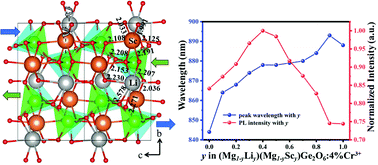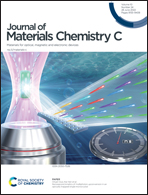Consequence of optimal bonding on cation ordering and enhanced near-infrared luminescence in Cr3+-doped pyroxene oxides†
Abstract
Cr3+-activated near-infrared (NIR) materials are currently attracting extensive attention owing to emerging NIR spectroscopic applications. One promising strategy to tune the excitation and emission spectra is to modulate the compositions and local structure of the host via solid-solutions. However, the intermediate compositions generally have poorer thermal luminescence stability, limiting their practical applications. Herein, we demonstrate that intermediate compositions in pyroxene solid-solutions, (Mg1−yLiy)(Mg1−yScy)Ge2O6:4%Cr3+ (y = 0–1), are better phosphor hosts for Cr3+, possessing higher internal quantum efficiency and thermal luminescence stability. The orthorhombic pyroxene shows more efficient luminescence than the monoclinic one. Ordered occupancy of Li+ and Sc3+ ions in two octahedral sites can optimize bonding and form a more rigid structure, leading to intermediate compositions having enhanced luminescence properties. The composition with y = 0.4 shows a broadband emission centered at ∼874 nm with internal/external quantum efficiencies of 66.6%/31.5%, respectively, and a thermal quenching temperature of up to 410 K. A NIR pc-LED is fabricated to demonstrate its applications in nondestructive detection and night vision imaging. This work provides a strategy for enhancing luminescence through structural optimization.

- This article is part of the themed collection: Journal of Materials Chemistry C HOT Papers


 Please wait while we load your content...
Please wait while we load your content...